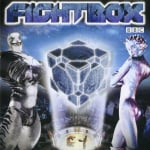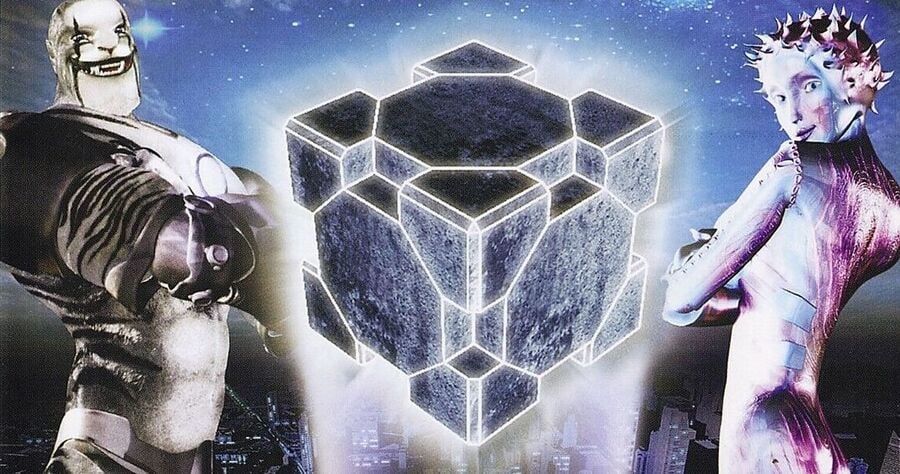
Video games and TV have always had a bit of a difficult relationship. For every success like GamesMaster, there have been countless failures that have struggled to capture what people love about the popular pastime. So, when the BBC spent an estimated £3-4 million on a new video game TV show, called FightBox in the early 2000s, fans were inevitably a bit skeptical about its chances of success.
The show, which aired on BBC Three and BBC Two in 2003 (initially as a replacement for Robot Wars) featured an innovative premise that saw contestants design and battle digital avatars in front of a live studio audience. Competitors faced off in a variety of events against other players, as well as the show's mascots — a group of warriors called The Sentients.
The BBC had hoped that FightBox would capture the interest of families (particularly those who loved gaming) and become a regular part of its programming, but in the end, production issues, low ratings, and a negative response from the media meant that it only lasted for a single season. We wanted to find out more about what went wrong with this ambitious yet flawed TV show, so earlier this year we tracked down its executive producer Finbar Hawkins, and producer Tobias Sturt to hear all about its troubled development. Before we get into all that though, we first need to talk about Bomb Productions.
FightBox Is Born
Bomb Production was a London-based web agency that Hawkins originally founded in 1998. At the time, he was the company’s creative director, while Sturt — his best friend from university — was employed as a producer — or as Sturt now jokes “an untethered and insufficiently supervised creative". Together the pair had worked on a project for Lastminute.com, for whom they'd developed an interactive murder mystery drama called Two Minutes, but what they really wanted to do was move into producing cross-media projects for TV.
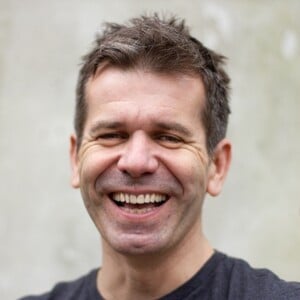
In order to accomplish this, the agency formed a close relationship with another producer named Nick Southgate at the production company, Ricochet, which specialized in documentaries and what it called "fact-based entertainment". All they needed was a million-dollar idea.
As Hawkins tells us, "We were throwing stuff around and FightBox came out of, 'Wouldn’t it be amazing to do something like Robot Wars but in a virtual way?' You’d have all the apparatus to build your own robot, and build your own warrior. So wouldn’t it be great to take advantage of all the interactive [possibilities] around that? So, you could build it at home, train it at home, and then there was an element — I think Popstars was around at that time — where you’d get selected and to get onto the show would be a competition itself, and then there would be a live final."
Sturts adds, "The sort of short answer [of how FightBox came to be] is in the New Inn Pub on Old Street. Because we were all in our twenties and there was a pub directly opposite [our offices].
"At some point, we had a Dreamcast that a lot of designers played Soul Calibur on and the whole agency would sort of gather around and watch people battle and you would have these sort of informal tournaments where people would drop in and out. That and then everybody playing Quake became this thing where people in the office were treating it almost as a spectator sport, and that then fed into some pub conversation about ‘Could you actually do it? Could you present it as a sport on television?’, which is where FightBox came from."
In the aftermath of the meeting in the pub, the two companies saw some potential in taking this idea further and got to work on fleshing out the concept. What they came up with was a gladiatorial-style event, where contestants could compete in various trials with their own digital creations inside a studio. How this worked is that players would be able to access a version of the game at home via a website, where they could design avatars, train, and then face off for a spot on the leaderboard. The producers would then select from the best of the best to come into the studio, where they would go head-to-head live on air.
During this period of pre-production, Bomb Productions put together a story bible for the world, coming up with an original backstory for the show about six powerful warriors named The Sentients and a fictional tournament to find their latest recruit. In addition to this, the team also developed what they describe as a "mood video" for the project, to try and envision what this show could actually look like on television. The latter involved editing together a bunch of clips from a range of different media to find the tone and the right kinds of moments that they wanted to replicate onscreen.
"[That was probably] the most enjoyable part of the process," Sturt tells us. "The producer/editor Kain Tietzel, art director Will Richards, and I just sat in an editing suite cutting together fight scenes from movies, to create the ultimate fight scene and talked about the rhythm of fight scenes and how we would try to capture that as a sport. So it was like the Subway battle in The Matrix, for example, and Toshio Mifune in Yojimbo. We were putting together lots of things and lots of periods to try and get a sense of this is going to work televisually."
"[That was probably] the most enjoyable part of the process. The producer/editor Kain Tietzel, art director Will Richards, and I just sat in an editing suite cutting together fight scenes from movies, to create the ultimate fight scene...
"There was a mood video created to get the tone of the show across," says Hawkins. "Wow, I've not thought of that for a long time. It featured a bunch of epic, thrilling, and funny fight moments: the Neo and Morpheus kung-fu fight, Takeshi's Castle, Tex Avery slapstick, Muhammed Ali knocking out Sonny Liston, etc."
While Bomb was working on nailing these particulars, it was also working with Ricochet to find out whether a "video game TV show" was actually possible. At the time, neither company had any prior experience in creating 3D gaming engines nor knew whether the technology even existed to present a show like this. So, they began searching for a camera rig that was capable of the real-time compositing they required. This was a lengthy process, which involved speaking to a bunch of different companies including one entity whose camera technology was allegedly used in Israeli missile systems. Eventually, though, they stumbled across the BBC's 'FreeD' Virtual Camera System — a special camera system that the BBC had set up in several of its studios to create real-time virtual sets
The BBC Gets Involved
How FreeD worked was that each camera had a small box on top of it that contained another miniature camera and LEDs to triangulate its position inside a 3D space using tiny markers, which were attached to the ceiling. This made it possible to composite digital elements directly into an image as it was being filmed, rather than doing everything in post-production.
The system was exactly what they were looking for, and so Bomb and Ricochet eventually set up a meeting with the BBC's production in early 2002, to discuss the possibility of a pilot. The two companies hired out a small studio at the BBC and enlisted the help of the Yorkshire-based game developer named Runecraft — who was best known at the time for creating licensed games like Barbie: Explorer, Jim Henson's The Hoobs, and Butt Ugly Martians: B.K.M. Battles — to build a quick fighting rig.
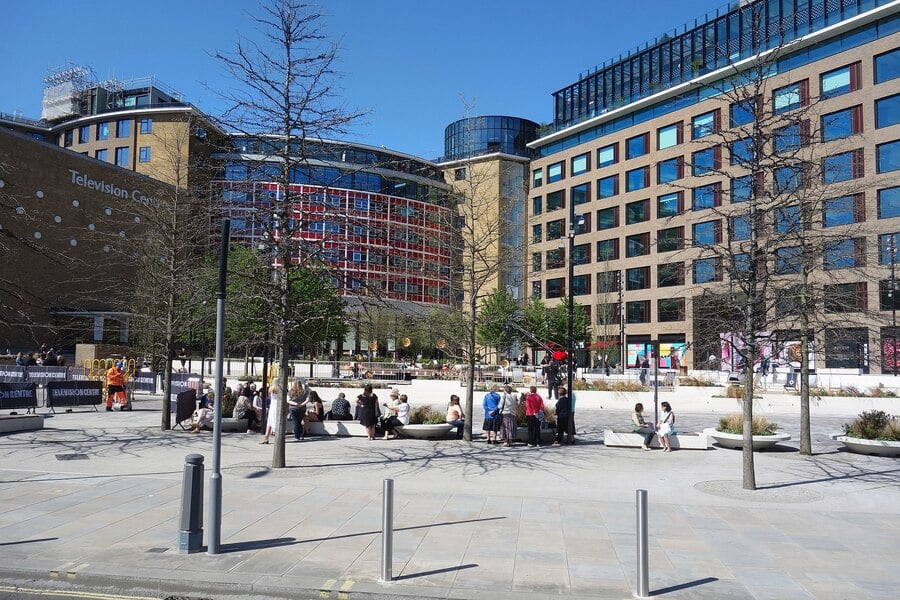
"We created a pilot out of the BBC," remembers Hawkins, "It was like a five-minute pilot using this setup. We’d found somebody who could help us and they set up a little kind of fighting rig with the characters, and we got a live audience and a presenter and slapped some Fat Boy Slim on it — “Right Here, Right Now”. Stuart Murphy, who was the controller of BBC Three, saw that and that’s how the ball started rolling."
We’d found somebody who could help us and they set up a little kind of fighting rig with the characters, and we got a live audience and a presenter and slapped some Fat Boy Slim on it — “Right Here, Right Now”. Stuart Murphy, who was the controller of BBC Three, saw that and that’s how the ball started rolling
In the aftermath of the pilot, BBC Three and BBC Two commissioned FightBox in November 2002, with BBC Worldwide contributing to the show’s budget and BBC Online (then BBCi) agreeing to liaison with Bomb Productions on the creation of its website. The idea was to launch the website aspect of the cross-media project in March 2003, with the show to debut in the Autumn of the same year on BBC Three, followed by BBC Two. With the clock now ticking, BBC Worldwide encouraged Bomb and Ricochet to solicit pitches from potential development partners, with the candidates including Runecraft (who had already helped out on the pilot), and two other UK studios: Kuju and Warthog.
"[Kuju] told us, 'This is reality. We can build this for you and we can do this, but you need to move your broadcast date and your TX date to this,'" says Hawkins. "[We] were aghast: 'We can't possibly do that. Don't you understand television?' But they were quite right: they gave us reality. Then [Warthog], another studio, gave us their version of reality, and this is also a good one. They said, ‘Well, why are you building it? Just do it in post [production]'. But we were trying to do everything really purist, like, ‘No, we need to build this system to function live, and we need to tie our game engine in.’ That was our vision."
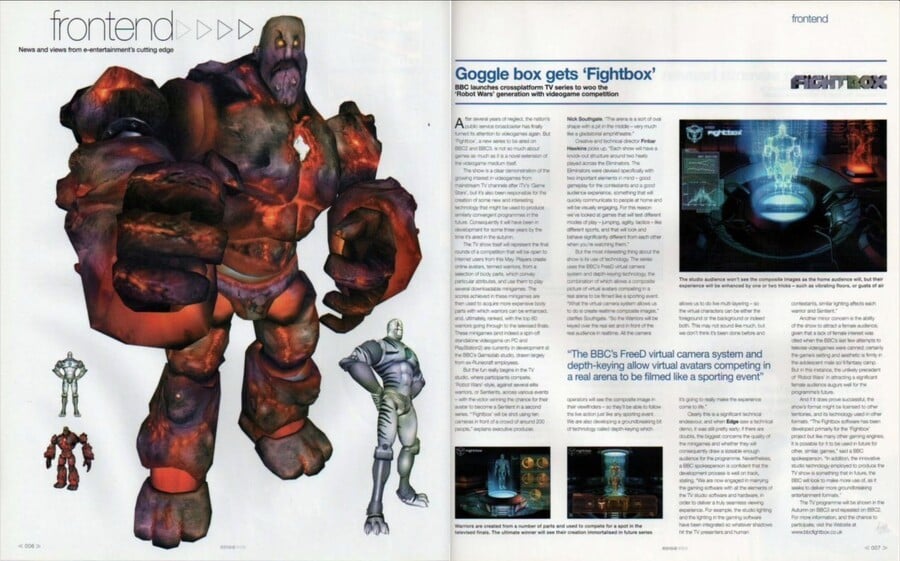
In the end, Bomb and Ricochet decided to stick with Runecraft, as it was the only one to assure them that it could deliver the engine and assets in time for broadcast. Hawkins and Sturt believe now, though, that they were probably just telling them what they wanted to hear.
"The people we ended up working with were — and again, this is slight naivety — very adamant that they could build a [full] fighting engine and have it ready for TV and interfaced with the BBC’s technology in time," says Sturt. "[In hindsight], we probably should have questioned that a little bit more."
Lights, Camera, Action
Following the commissioning of the show, life became hectic for its various creators. Ricochet immediately began the arduous process of hiring the crew and the presenters, as well as designing the sets, while Bomb worked on the website with BBCi and liaised with Runecraft to create the individual events that contestants would be participating in. According to Hawkins, he spent a significant amount of time during this period travelling by train up to Yorkshire to meet with the game developers before commuting back down to London again, to participate in meetings with the various departments of the BBC.
"There was no easy way [to do it remotely back then]," Hawkins tells us. "It was basically you and a group of game designers and developers. We’d do a lot of [the planning] in the car park actually because it was about the mapping of physical space. You had to be thinking about this in TV terms, it had to be a visual thing, right? So that was all part of it, and then I would liaise closely with Nick. [...] I was repeating myself a lot because you’d be in these meetings and constantly drawing it — ‘This is where this goes’ — so people could get their heads around it. It was hard to get people to understand really."
The final design of the show was put together under a tremendous time crunch but somehow the team managed to get everything in order. In the end, all parties agreed that the show would be filmed on an amphitheater-style set in Studio One, with the audience facing a screen that was positioned above the pit to show them what was being captured live on the cameras.
Contestants, meanwhile, would sit inside different-coloured pods located on the arena floor, where they would be able to control their avatars via a desktop computer synced up to the BBC's technology. How the show was formatted was that each episode would include four different contestants, who would compete in two different brackets containing two events from the following list:
- Conquest - Players must walk over tiles to claim as much land as possible within a time limit while also avoiding various traps.
- Demolition - Played one at a time. Contestants must smash blocks to earn points. The blocks may also contain unexpected surprises such as enemy Sentients and Zombie Warriors.
- Duel - Contestants battle against The Sentients with special pick-ups that are scattered around the arena. Players must keep landing attacks to rack up more points.
- Helix - A spiral-shaped obstacle course that is played one at a time. Points are awarded based on how quickly players can reach the top.
- Panic - A versus-style game where players must keep smashing blocks to score as many points as possible. Two Sentients' are gradually lowered into the arena as the event is underway.
- Revolution - A head-to-head game where players must collect cubes in order to score points. The most valuable cube spawns in the center of a revolving platform that is patrolled by the Sentients.
The winner of each bracket would then go on to fight in one last "Showdown" event, which was a straightforward one-on-one battle featuring the two finalists.
To add to the show's live atmosphere, the events would feature play-by-play commentary from The World's Strongest Man announcer Paul Dickenson, interviews between the contestants and the presenters Trevor Nelson and Lisa Snowden, and special FightBox cheerleaders who would taunt the losers as they left the arena. It was all beginning to look like the show was finally coming together but as the preparations got underway for filming, pretty much everything that could go wrong did.
For starters, the game studio Runecraft, who had been helping out on the project, went bust during production. So, as a result, BBC Worldwide had to reluctantly swoop in and acquire the developer, to ensure the show and its various video game tie-ins stayed on track. The BBC ended up renaming the company Gamezlab, where it eventually became part of BBC Multimedia, operating with a reduced headcount.

As if all that wasn't bad enough, on the first day of filming, which took place in July 2003, there were also some pretty severe technical issues. As Bomb and Ricochet got ready to begin shooting, the BBC's production crew turned on its cameras to see various black blobs running around in place of the 3D characters. Production stalled for two additional weeks, with BBC Worldwide having to pay to keep Studio 1 and the crew locked down until the issue was resolved.
These obviously weren't the greatest of omens, but the show did eventually manage to overcome these issues and finish filming all 20 episodes of its first season.
An Unfortunate End
The first episode of Fightbox was broadcast on BBC Three on the 13th of October at 7:30pm, with additional episodes being aired every weekday in the same time slot. However, just a few weeks later, it became clear that it was struggling to find an audience on TV, despite the success of its website. On November 5th, 2003, The Guardian wrote an article entitled "BBC3's Fightbox on the ropes", in which noted that the show had undergone a dramatic fall in its viewership from a high of 56,000 viewers on Thursday, October 30th to just 6000 viewers the following day. This was a figure, The Guardian noted, that was "perilously close to a zero rating in the BARB audience measurement system."
Its creators hoped that the show might pick up some more viewers when it aired on BBC Two later in the year, but after a short stint in Robot Wars' old time slot on a Friday evening, it was moved to a Sunday morning "children's slot" instead, severely limiting its potential audience. Over time, it became clear that this was the result of a certain senior individual within BBC Two who had taken a disliking to the show and was already getting ready to pull the plug.
"[The controller of BBC 2] Jane Root hated it," says Sturt. "The time slot move was the sign of ‘Oh okay, you’re not even going to try and get an audience for this? You’re just going to dump it.’"
"Nick [Southgate] called me, and I just felt sick," Hawkins adds. "Because that killed us. It’s great if you’re a young kid watching that, but in terms of targeting the people they actually wanted to target, it's obvious we weren't hitting the numbers or [Jane Root] didn’t like the look of it. I managed to grab her — not literally — but I managed to get to see her and say, ‘Did you see it?’ [...] It was all a bit like Alan Partridge looking for a second [season]."
It was clear to its creators from the change in time slot that the FightBox experiment was over. There wasn't going to be a second season, and the BBC was already ready to admit defeat. For its creators, it was heartbreaking. The show had been plagued with technical issues and bad luck and had cost BBC Worldwide much more than it had initially anticipated, but the belief was that they could gradually smooth off its rough edges over time. Unfortunately, though, they never got the chance.
In early 2004, BBC Multimedia announced three video games based on FightBox, for the PC, PS2, and Game Boy Advance — all of which had been in development before the BBC had shut down hopes of a second season — but without new episodes to generate interest they were pretty much dead on arrival.
It was a sad ending for a project that the BBC had once had such high hopes for. And to rub salt in the wound, not long after, another BBC show came along called Bamzooki, which seemed to do the same thing, albeit for a younger audience. That show also used the BBC's 'FreeD' technology and focused on creating and battling small virtual robots called 'Zooks'. It went on to become a huge success, eventually lasting four seasons and a total of 56 episodes. Fightbox, on the other hand, was mostly forgotten except by those who worked on it and those who took part.
"It didn’t quite work as a game show," says Sturt, reflecting on the show today. "It didn’t get the structure right, it didn’t quite get the rhythm right. Which is the thing we could have improved on. I think we didn’t quite nail the tone. There was quite a big battle behind the scenes between us and the TV people, where the TV people wanted something a lot more game show understandably because they knew the audience they were trying to reach and we were kind of being super serious and po-faced about it. And actually, that meant that it didn’t quite find its tone. We needed to have all aligned in one direction and really gone for it."
"It got covered in the politics," Hawkins says. "And it had a lot of bad luck with it in terms of the studio going bust. But that’s what I mean about fighting for it because I could see it. There is something here and if we could break through with this it will evolve the way we experience entertainment."
Today, some of the old episodes have been uploaded to YouTube. So, if you fancy seeing the show for yourself, you can view most of it online and form your own opinion.

